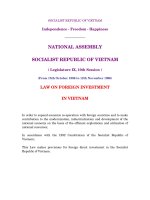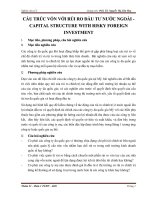Capital investment appraisal 2
Bạn đang xem bản rút gọn của tài liệu. Xem và tải ngay bản đầy đủ của tài liệu tại đây (9.83 MB, 22 trang )
Chapter 20: Capital investment appraisal
On completion of this topic you should be able to
Explain the purpose of capital investment appraisal
Calculate and interpret the payback period for an
investment project
Calculate and interpret the accounting rate of return for
an investment project
Describe the advantages and disadvantages of these two
techniques
Independent study
Study Chapter 20
Progress test and practice question(s) as set
Business Accounting
1
Capital investment appraisal
Whilst cost accounting provides information to management for making short-term decisions about revenue
expenditure, this topic provides information for long-term decisions about capital expenditure
Capital investment appraisal is ‘the evaluation of proposed investment projects, with a view to determining which is
likely to give the highest financial return’ (Collis and Hussey, 2007, p. 335)
Business Accounting
2
Characteristics of capital investment decisions
Time span
2+ years
Nature
Strategic (eg whether to build or buy a
new factory)
Level of
expenditure
Medium – high
External factors
Very important (eg interest rates and
rates of inflation)
Typical techniques
Payback period
Accounting rate of return
Discounted cash flow techniques
Adapted from Jones, 2002, p. 452
Business Accounting
3
The capital investment decision
Capital investment appraisal techniques are used for making decisions concerning the investment of large amount of
capital in a long-term project
Management needs to know that the investment project will be worthwhile
Either it will generate more cash than the initial amount
invested or it will provide cost savings over the life of the
project that will exceed the capital invested
At the very least, management needs to know that the business will get its money back
Business Accounting
4
Exercise 1
Capital investment decisions
Business Accounting
5
Exercise 1
Capital investment decisions
Business Accounting
6
Solution 1
Capital investment decisions
Business Accounting
7
Solution 1
Capital investment decisions (continued)
Machine 3 looks best as the net cash inflow is £25,000 (£5,000 higher than for Machines 1 or 2)
But waiting until Year 3 to get most of the cash increases
risk – the annual net cash flows are estimates and the
further ahead the forecast, the more unreliable it is
Machines 1 & 2 both give the same total net cash inflow, so either is worth considering, but Machine 1 is the more
favourable because the cash comes in sooner
It’s difficult to decide - we need a technique to help
Business Accounting
8
Capital investment appraisal techniques
Capital investment
appraisal
Payback period
Accounting
rate of return
Business Accounting
Discounted
cash flow
9
Payback period
The payback period is ‘the time required for the predicted net cash flows to equal the capital invested in a proposed
investment project’ (Collis and Hussey, 2007, p. 338)
The project that repays the capital invested in the
shortest time is considered to be the most favourable
The following estimates are needed
The amount of capital required
The amount and timing of the net cash flows
generated by the investment project
Business Accounting
10
Conventions and assumptions
Year 0 is a conventional way of referring to the start of Year 1
Year 1, 2, 3 etc means the end of Year 1, 2, 3, etc
It is assumed that the cash outflow from the initial investment of capital will take place at Year 0
It is assumed that the net cash inflows during a year will be received evenly throughout the year
Negative cash flows are shown in brackets
Business Accounting
11
Exercise 2
Mr Cornetto’s ice cream van project
Business Accounting
12
Solution 2
Mr Cornetto’s ice cream van project
The payback period for the ice cream van project is
Initial capital investment = £12,000
Annual net cash flow
£4,000
= 3 years exactly
We have been able to use this formula because Mr Cornetto expects the net cash flows to be the same every year over
the life of the project, but we can’t use it if the projected annual net cash flows are expected to differ…
Business Accounting
13
Exercise 3
Mr Cornetto’s pasta van project
An alternative project is to invest in a pasta van that will also cost £12,000 and last 4 years
Because take-away pasta may take some time to catch on, the annual net cash flows are expected to be £2,000 in year
1, rising to £3,000 in year 2, £5,000 in year 3 and £6,000 in year 4
Required
Using the pro forma, calculate the payback period in
years and months for the pasta van project
Business Accounting
14
Pro forma
Mr Cornetto’s pasta van project
Business Accounting
15
Solution 3
Mr Cornetto’s pasta van project
Business Accounting
16
Advantages and disadvantages of payback period
Advantages
Simple to calculate and easy to understand
Useful for risky projects where prediction of future cash
flows beyond first few years is difficult (eg IT)
Useful if short-term cash flows are more important to
survival of the business than long-term cash flows
Useful if borrowing or gearing is a concern
Disadvantages
Does not take account of the time value of money (cash
now is worth more than cash received later)
Ignores cash flows after the payback period
Business Accounting
17
Accounting rate of return
The payback period focuses on cash flows, but the accounting rate of return (ARR) focuses on profit
The accounting rate of return ‘measures the predicted average profit before interest and tax as a percentage of the
average capital employed in a proposed investment project’ (Collis and Hussey, 2007, p. 342)
When comparing ratios from different sources, care must be taken that the same definition of profit and capital
employed have been used
Business Accounting
18
Exercise 4
Fresh Farm Foods ARR
Business Accounting
19
Pro forma
Fresh Farm Foods ARR
Business Accounting
20
Solution 4
Fresh Farm Foods ARR
Business Accounting
21
Conclusions
Advantages and disadvantages of ARR
Advantages
Simple to calculate and easy to understand
Takes account of the entire life of the project
Compatible with the performance ratio, ROCE
Disadvantages
Does not take account of the time value of money
Ignores the timing of profits (eg benefit of earning a larger
proportion of profit in early years) and timing of cash flows
No standard definition of terms (limits comparisons)
Averages can be misleading (actual figure may be ↑ or ↓)
No guidance on what is an acceptable rate of return
Business Accounting
22









